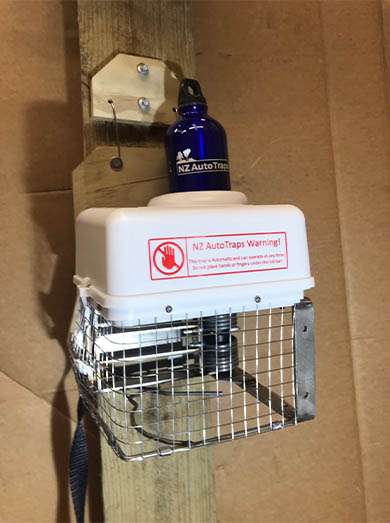Steps to choose
The following steps are recommended by Predator Free 2050 community groups:
- consider site-specific factors and ask your Predator Free Ranger for guidance
- read advice on trap and bait lines to avoid poor results
- buy the right traps – the Predator Free NZ Trust shop stocks a range of traps
- expand your supplies with a fuller range of equipment such as monitoring and bait stations.
Single action traps
All single action kill traps listed below are set in a tunnel or cover. Some are separate components that may need to be assembled and maintained correctly, while others are an integrated part of the purchased trap.
The cover or tunnel guides the animal to ensure humane killing and shelters the trap limiting the risk of by-kill and interaction from nontarget species.
When to use toxins instead of traps
- If there are higher pest densities at your site, trapping will be labour intensive and inefficient unless the traps are self-resetting. Toxins are often a better choice in such circumstances.
- Your local pest populations can become trap shy or poison shy if you stick to the same control method for a long time. Changing the tool can help you reach more targets.
Any traps listed below have passed NAWAC testing guideline and list of species for humane trapping.
DOC series 150, 200, and 250
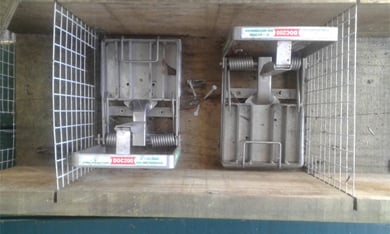
DOC-200 double-set trap
Image: Erana Stevens-Tulip | DOC
Kill targets: weasels, stoats, ferrets, and rats
Best for:
- DOC 150, 200: weasel, stoat and rat control
- DOC 250: ferret control
Pros: long service life, proven effective
The DOC series:
- must be used inside a covered tunnel box following best practice tunnel design
- requires some expertise to check the trigger sensitivity over time
- comes in single-trap or double-trap combinations – doubles are recommended for stoat control
- may require box modification to exclude non-targets, such as small children, weka, and kea.
It is recommended that the side or extended entrance tunnel designs are used in areas where domestic cats may be present. For kea/weka area DOC-series tunnel designs contact your local DOC office.
- Download kea/weka tunnel designs or order reinforced hardware components.
- Watch how-to videos about the DOC-200 trap.
Download technical guide
DOC series best practice tunnel designs (PDF, 2,422K)
Lure
For weasels, stoats, ferrets:
- fresh rabbit meat
- Connovation Erayz (salted rabbit)
- Connovation PoaUku long life lure
- eggs – less attractive but longer lasting or Connovation Eggsellent Lure.
For rats:
- peanut butter – Connovation Ferafeed, peanut butter mixed with rolled oats
- other nut-based or chocolate lures.
BT 200 and 250 trap
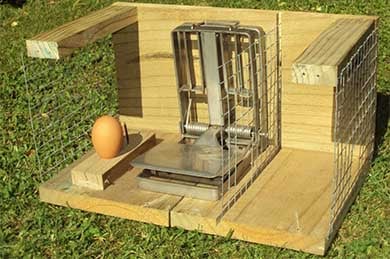
A BT 200 trap cutaway
Image: National Springs & Wire Products NZ Ltd ©
Kill targets: stoats and ferrets
Best for:
- BT200: stoat, weasel and rat, control
- BT250: ferret control
Pros: long service life, proven effective
The BT200 and BT250 traps come in both zinc plated and full stainless options with good solid weld points. It is recommended that the extended DOC 200 tunnel design is used in areas where domestic cats are present.
The BT200 is 2 mm larger than the DOC 200 version, so take extra care of distance between trap and tunnel walls when installing into a DOC-series wooden tunnel design.
Lure
For weasels, stoats and ferrets:
- fresh rabbit meat
- Connovation Erayz (salted rabbit)
- Connovation PoaUku long life lure
- eggs – less attractive but longer lasting, or
- Connovation Eggsellent Lure.
For rats:
- peanut butter (Connovation Ferafeed, peanut butter mixed with rolled oats)
- other nut-based or chocolate lures.
PodiTrap
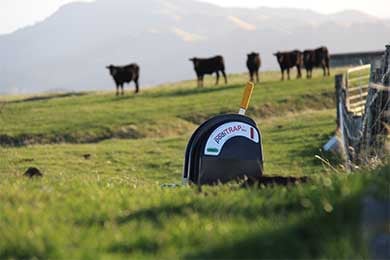
The trap has an easy to use handle
Image: PodiTrap ©
Kill targets: ferrets
Best for: ferret control
Pros: new technology, easy to set, safe and convenient
The trap can be easily set from the outside without tools. The handle is used for setting and works as a ‘flag’: a raised handle indicates it is set, a lowered handle that it needs resetting – no need to check every trap.
The trap is also designed so users cannot open the trap once set. Its stackable plastic housing makes it light and portable.
Lure
For ferrets:
- PodiTrap bait
- fresh rabbit meat
- Connovation Erayz (salted rabbit).
Rewild F-Bomb

A Rewild F-Bomb trap
Image: Rewild ©
Kill targets: ferrets, stoats and rats
Best for: ferret, stoat and rat control
Pros: new technology, compact, lightweight, safe, and easy to use
The Rewild F-Bomb trap is a single set and is designed around an integrated tunnel-and-trap mechanism.
It is also designed to be safe for the user, particularly for a trap of this power.
Lure
For rats:
- peanut butter (Connovation Ferafeed, peanut butter mixed with rolled oats)
- other nut-based or chocolate lures.
For ferrets and stoats:
- Fresh rabbit meat
- Connovation Erayz (salted rabbit)
- eggs – less attractive but longer lasting.
A24 trap
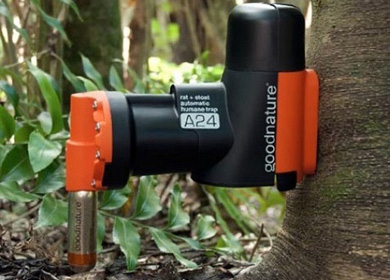
A24 self-resetting trap by Goodnature
Image: Goodnature ©
Kill targets: stoats, weasels, and rats
Best for: controlling rats when trapping is the preferred control option
Pros: new technology, labour saving, no resetting required, continuous kill
The A24:
- is a self-resetting trap
- can trigger 24 times before needing a CO2 canister change.
Lure
For rats: Goodnature Rat Lure
For stoats: Goodnature Stoat Lure
Victor Professional PCR Model
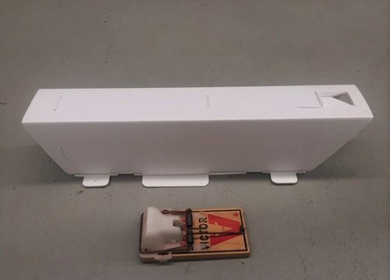
Modified Victor trap with tunnel
Image: Pest Control Research ©
Kill targets: stoats and rats
Best for: controlling low-density rat populations over small areas
Pros: cost effective, small, light and easy to set
The Victor modified trap is a Victor rat trap with a plastic fitting which makes it humane and suitable for targeting stoats.
Use inside a tunnel or plastic pipe to shelter the trap and limit the risk of by-kill.
Watch a how-to video about the modified Victor trap.
Lure
For stoats:
- 'Mustelid & Cat & Rat Lure' by Traps.co.nz
- Connovation Erayz
For rats:
- 'Mustelid & Cat & Rat Lure' or 'Rat & Possum Lure' by Traps.co.nz
- chocolate or peanut butter.
Victor Professional
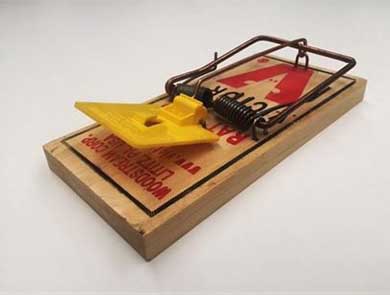
Victor Professional trap
Kill targets: rats
Best for: controlling low-density rat populations over small areas and backyard trapping.
Pros: cost effective, small light and easy to set
Suitable for trapping in native forest where ship rats are most prevalent.
Use inside a tunnel or plastic pipe to shelter the trap and limit the risk of by-kill.
Lure
For rats:
- 'Mustelid & Cat & Rat Lure' or 'Rat & Possum Lure' by Traps.co.nz
- chocolate or peanut butter.
Envirotools – D Rat, Lumberjack, and Supervisor Max
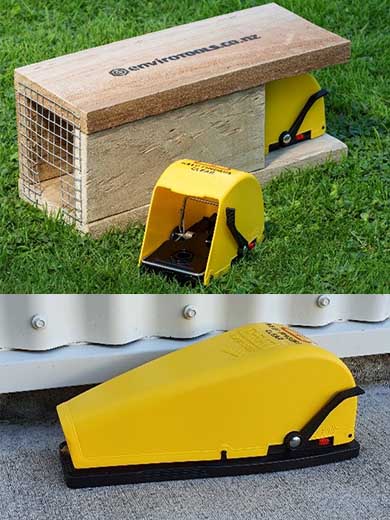
Shown on the top is the Envirootools D-Rat Lumberjack model. On the bottoms is the Envirotools Envirotools Supervisor Max
Kill targets: rats
Best for: controlling low-density rat populations over small areas and backyard trapping
Pros: safe for children and pets, cost effective, easy to use
The range of Envirotools traps are designed and manufactured in New Zealand specifically for New Zealand conditions. Made from stainless steel and UV-resistant polymer.
Lure
For rats:
- 'Mustelid & Cat & Rat Lure' or 'Rat & Possum Lure' by Traps.co.nz
- chocolate or peanut butter.
NZ Autotraps AT220
Kill targets: possums and ship rats
Best for: controlling ship rats and possums at medium to low densities
Pros: new technology, labour saving, no resetting required, continuous kill
The AT220:
- has passed NAWAC testing guidelines for humane trapping of possums and ship rats
- is a self-resetting and rebaiting kill trap made by NZ Auto Traps
- up to 100 cycles without the need to tend to and reset
- 6 months between service – only requires checking every 6 months.
Lure
For possums and ship rats: NZ Autotraps possum lure – flour, sugarfats, aniseed, and cinnamon mixed with peanut oil.
Trapinator
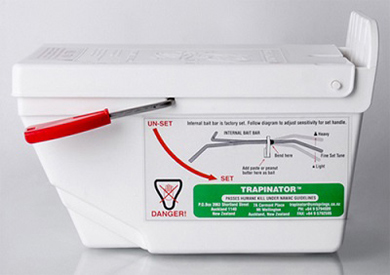
Trapinator
Image: CMI Springs ©
Kill target: possums
Best for: controlling low-density possum populations
Pros: proven effective, safe, easy to set, lightweight
The Trapinator is:
- an all-in-one spring-set kill mechanism in a plastic box
- mounted by screws onto trees, 1 m above the ground.
Watch a how-to video about the Trapinator
Lure
For possums:
- peanut butter
- Connovation Smooth in a Tube
- possum Dough by Traps.co.nz.
Envirotools Flipping Timmy
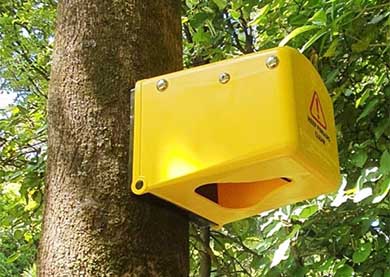
A Envirotools Flipping Timmy on a tree
Kill targets: possums
Pros: new technology, lightweight, safe, easy to use
The Flipping Timmy possum trap is based on the Timms trap. It is mounted vertically removing the need to bend over which ensures a clean catch area.
The Flipping Timmy meets NAWAC’s humane trap-testing guidelines.
The trap is designed for a long life with stainless steel components and UV resistant polymers. It is guaranteed by the manufacturer for 5 years.
Sentinel
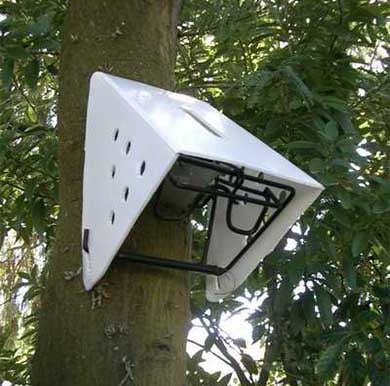
A Sentinel trap on a tree
Kill targets: possum
Pros: proven effectiveness, lightweight, cost effective
The Sentinel is a lightweight possum trap set suitable for use in remote areas of native forest where the portable design allows more traps to be packed in.
Has a white Corflute cover for visibility and to orientate the possum to the trap. Each set includes trap, tree attachment, bait clip and Corflute cover.
Lure
For possums:
- peanut butter
- Connovation Smooth in a Tube
- possum Dough by Traps.co.nz.
Warrior
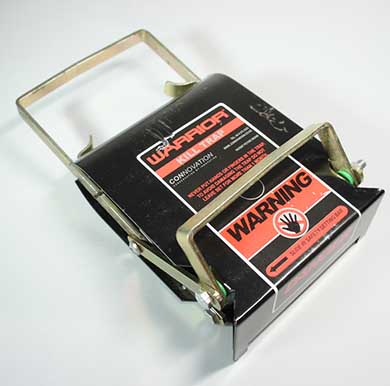
A Warrior trap
Kill targets: possums
Pros: proven effectiveness, long service life, robust and durable
The Warrior is lightweight (850 g) easy-tocarry possum trap. It has a 1.6 mm thick annealed spring steel body.
With a strong, rigid structure, it is designed to be fixed to a tree with screws, 1 m above the ground.
Lure
For possums:
- peanut butter
- Connovation Smooth in a Tube
- possum Dough by Traps.co.nz.
SA2 Kat trap
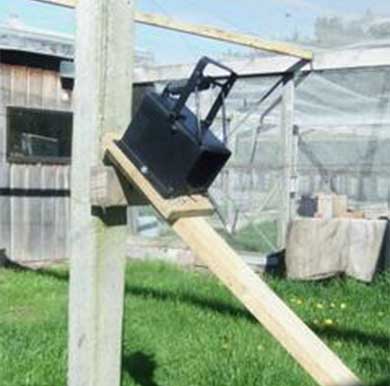
A SA2 Kat Trap
Kill targets: possum
Pros: proven effectiveness, robust and durable
Durable and robust, the SA2 Kat trap is an effective single-kill possum trap. The trap has passed NAWAC testing for possum and feral cats as a raised trap only.
It is recommended the trap is placed 750 mm above the ground on an angle (up to 45 degrees), but if weka are present this height and angle will need to be increased to 1.3 m and 55 degrees respectively.
Lure
For possums:
- peanut butter
- Connovation Smooth in a Tube
- possum Dough by Traps.co.nz.
Cholecalciferol toxin (vitamin D3)
Kill target: rats and possums
Best for: controlling rats or possums at medium to low densities
Pros: can be used without a licence; low secondary poisoning risk
Cons: pests can become bait shy if the bait is used incorrectly; requires a pre-feed
Cholecalciferol:
- is a naturally-occurring substance found in liver, fish oil, egg yolk and milk fat
- is often used as a health supplement, but is toxic in high doses
- must be used in bait stations for most PF2050 projects
- requires one prefeed of non-toxic bait.
Examples of cholecalciferol for rat control:
- Feracol
- LDC Feracol Paste Bait
- D3 Rat One Feed Bait
Examples of cholecalciferol for possum control:
- Feracol paste
- Feracol Strikers
- LDC Feracol Paste Bait
- Pestoff Decal Possum Bait
First-generation anticoagulant toxins
Kill target: rats
Best for: controlling rats where possum population densities are not high
Pros: does not require a pre-feed, can be used without a licence
Cons: ineffective in possum-infested areas (possums out-compete rats for the bait); potential for low kill rates if inadequate amounts are used; incorrect usage can lead to resistance in rats
First-generation anticoagulants:
- are weak, blood-thinning toxins that interrupt the body’s ability to clot
- require multiple bait applications over 1 wk period
- remain in the body for a shorter time than second generation anticoagulant other toxins, limiting the threat of by-kill of non-target species
- must be used in bait stations for most PF2050 projects
- do not require a pre-feed of non-toxic bait
- are safer than second-generation anticoagulants, which are suited to special cases only.
Examples of first-generation anticoagulants for rat control
- Coumatetralyl (Racumin Paste)
- Diphacinone (Ditrac All-Weather Rodent Block, RatAbate Paste, Pestoff Rat Bait 50D, D-Block for the Control of Rats (RatAbate Blocks), D-Block Extreme)
- Pindone (Pindone Pellets for possums and rats)
Diphacinone + cholecalciferol (D+C) toxic baits
Kill target: rats and possums
Best for: controlling rats or possums at medium to low densities
Pros: can be used without a licence
Because D+C baits are relatively new there is a limited amount of knowledge of effectiveness and how best to use
Diphacinone + cholecalciferol:
- the combination of the 2 different types of toxin has a synergistic poisoning effect
- should have higher potency than first-generation anticoagulants
- remain in the body for a shorter time than second generation anticoagulant other toxins, limiting the threat of by-kill of non-target species
- must be used in bait stations
- do not require a pre-feed of non-toxic bait
Examples of diphacinone + cholecalciferol baits for rat or possum control
- There is only one registered D+C bait, Double Tap
